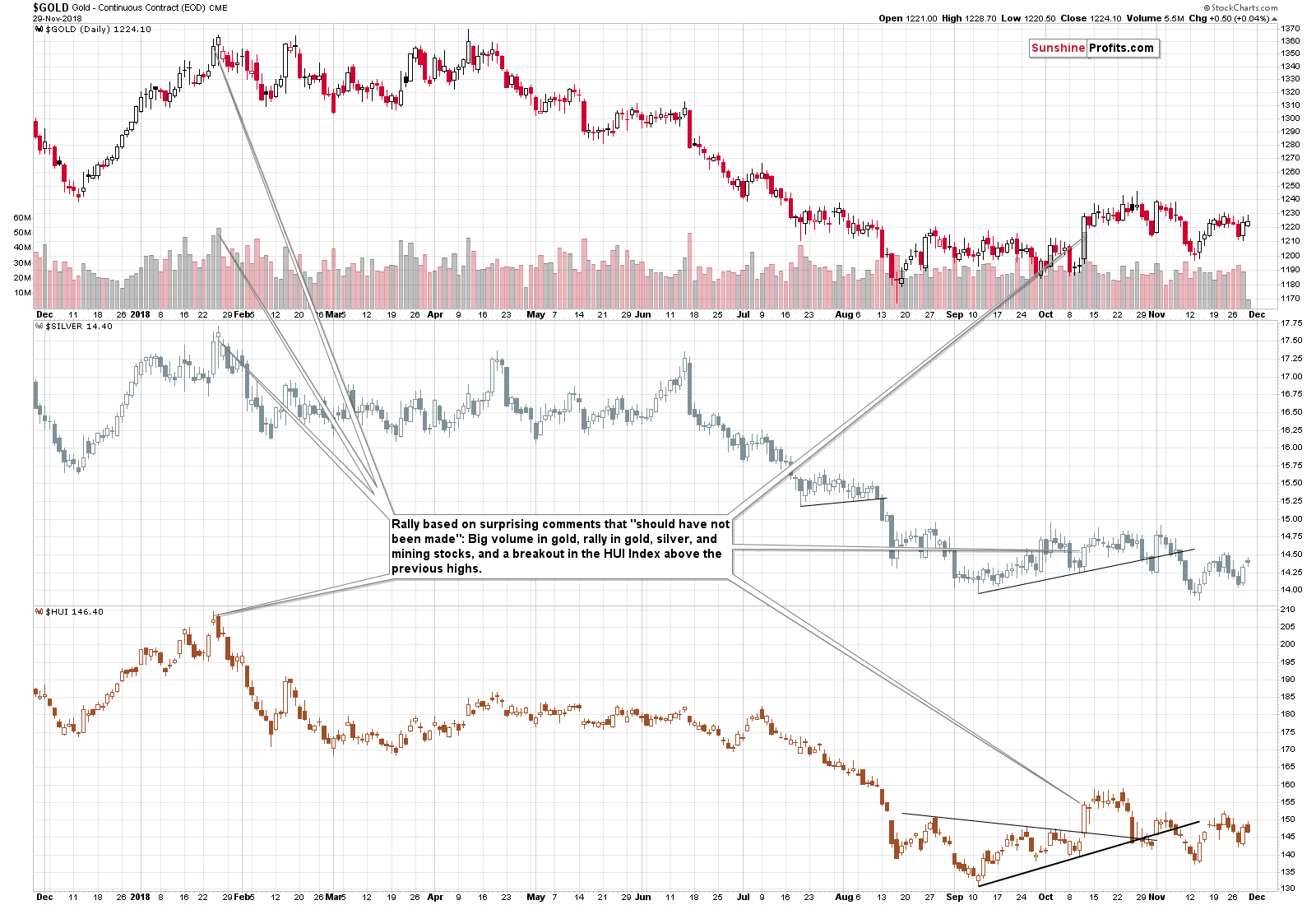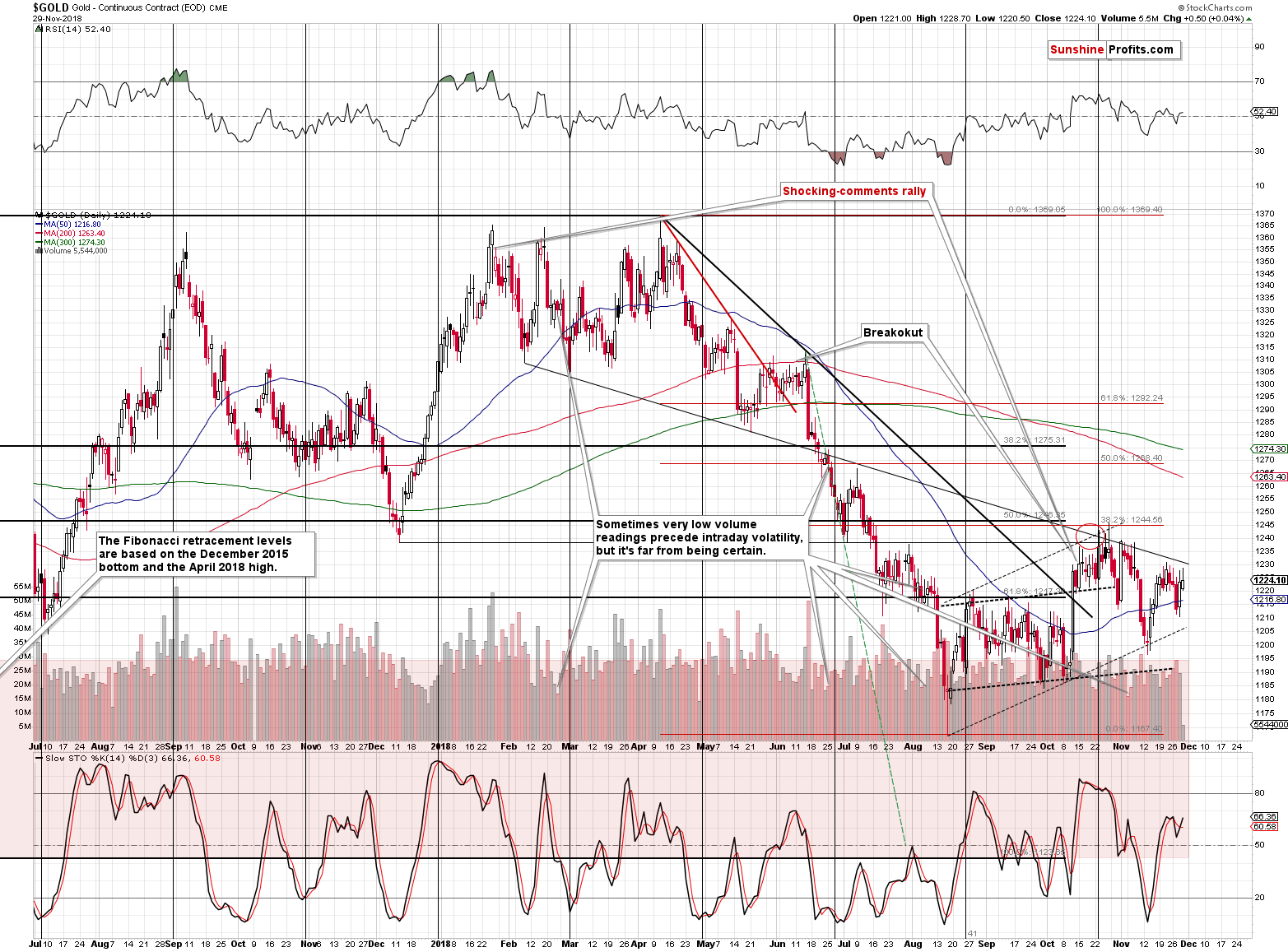Briefly: in our opinion, full (250% of the regular size of the position) speculative short positions in gold, silver and mining stocks are justified from the risk/reward perspective at the moment of publishing this Alert.
After a quite volatile beginning of the week, yesterday’s session didn’t cause much excitement among investors and traders as nothing seems to have happened. But, in reality, yesterday’s signs were subtle, but not absent. What can we infer from them?
Yes, you answered correctly. We can infer that the declines in the precious metals market are likely very close. We know that we have been writing this for many days and it probably sounds boring right now, but let’s keep in mind that the periods of very high volatility and very low volatility often follow each other. In fact, that’s one of the trading techniques – when the Bollinger Bands narrow (their width is based on volatility) very tightly, it means that a big move in either direction is likely. Back in April 2013, we also saw the calm before the storm and it wouldn’t be surprising to see it again this time.
Aren’t the markets calm right now? This means that it’s the exactly wrong moment to give up on the position. The bearish signals remain very strong and in case of the major price moves, it’s generally better to be prepared a few weeks (or even a month) too early than to be a few hours too late. And we’ll continue to provide you with the objective (best of our abilities) analysis and keep you updated regardless of how boring the situation appears.
There are two details that we would like to discuss today. One of them is the relative performance of gold vs. silver vs. mining stocks.

Gold closed just $0.50 higher yesterday, which means that it was basically flat. Silver closed visibly higher, while miners declined a bit. The discrepancy in performance is not huge, but it’s quite visible from the short-term point of view. If you’ve been following our analyses for some time, you know that silver tends to outperform right before the top (or at it) while miners underperform. And we just saw the above, so the implications are bearish.

Gold didn’t manage to reach, let alone break above the declining resistance line or the previous highs, so the trend remains down. What’s remarkable regarding yesterday’s small upswing is the size of the volume that accompanied it, which was extremely low. Low volume during an upswing means that the buying power is drying up.
Gold market upswings were triggered by quite significant news. Well, they were not likely to change the medium-term trend, but they were in line with events that have previously triggered massive upswings. The market just thought that the Fed will not increase rates and gold rallied, but the rally was not huge. Gold didn’t even move above the previous highs. And what about the tensions regarding the Ukraine? Gold soared when the tensions regarding Crimea peaked. What happened now? Almost nothing – no move above the previous short-term highs. Both reactions suggest that the strength of the buyers is now very weak and the tiny volume that we saw yesterday serves as a perfect confirmation.
We may not need to wait for much longer before the big slide starts, but even if it takes another week or even a few weeks, it extremely likely will be worth it.
Summing up, the outlook for the precious metals market remains very bearish for the following weeks and months and short position remains justified from the risk to reward point of view, even if we see a few extra days of back and forth trading or even a small brief upswing. It is a very high probability of a huge downswing that makes the short position justified, not the outlook for the next few days. It seems that our big profits on this short position will become enormous in the future and that we will not have to wait much longer. Gold’s inability to rally on the increased geopolitical tensions regarding Ukraine confirm this scenario and since Powell’s speech didn’t change anything (despite causing some short-term price action), the downtrend will likely resume shortly. The short-term outperformance of silver and underperformance of mining stocks confirm the bearish outlook and the same goes for the very small level of volume that accompanied gold’s small upswing.
As always, we’ll keep you – our subscribers – informed.
To summarize:
Trading capital (supplementary part of the portfolio; our opinion): Full short positions (250% of the full position) in gold, silver and mining stocks are justified from the risk/reward perspective with the following stop-loss orders and exit profit-take price levels:
- Gold: profit-take exit price: $1,062; stop-loss: $1,257; initial target price for the DGLD ETN: $82.96; stop-loss for the DGLD ETN $49.27
- Silver: profit-take exit price: $12.32; stop-loss: $15.11; initial target price for the DSLV ETN: $47.67; stop-loss for the DSLV ETN $28.37
- Mining stocks (price levels for the GDX ETF): profit-take exit price: $13.12; stop-loss: $20.83; initial target price for the DUST ETF: $80.97; stop-loss for the DUST ETF $27.67
Note: the above is a specific preparation for a possible sudden price drop, it does not reflect the most likely outcome. You will find a more detailed explanation in our August 1 Alert. In case one wants to bet on junior mining stocks’ prices (we do not suggest doing so – we think senior mining stocks are more predictable in the case of short-term trades – if one wants to do it anyway, we provide the details), here are the stop-loss details and target prices:
- GDXJ ETF: profit-take exit price: $17.52; stop-loss: $31.23
- JDST ETF: initial target price: $154.97 stop-loss: $51.78
Long-term capital (core part of the portfolio; our opinion): No positions (in other words: cash)
Insurance capital (core part of the portfolio; our opinion): Full position
Important Details for New Subscribers
Whether you already subscribed or not, we encourage you to find out how to make the most of our alerts and read our replies to the most common alert-and-gold-trading-related-questions.
Please note that the in the trading section we describe the situation for the day that the alert is posted. In other words, it we are writing about a speculative position, it means that it is up-to-date on the day it was posted. We are also featuring the initial target prices, so that you can decide whether keeping a position on a given day is something that is in tune with your approach (some moves are too small for medium-term traders and some might appear too big for day-traders).
Plus, you might want to read why our stop-loss orders are usually relatively far from the current price.
Please note that a full position doesn’t mean using all of the capital for a given trade. You will find details on our thoughts on gold portfolio structuring in the Key Insights section on our website.
As a reminder – “initial target price” means exactly that – an “initial” one, it’s not a price level at which we suggest closing positions. If this becomes the case (like it did in the previous trade) we will refer to these levels as levels of exit orders (exactly as we’ve done previously). Stop-loss levels, however, are naturally not “initial”, but something that, in our opinion, might be entered as an order.
Since it is impossible to synchronize target prices and stop-loss levels for all the ETFs and ETNs with the main markets that we provide these levels for (gold, silver and mining stocks – the GDX ETF), the stop-loss levels and target prices for other ETNs and ETF (among other: UGLD, DGLD, USLV, DSLV, NUGT, DUST, JNUG, JDST) are provided as supplementary, and not as “final”. This means that if a stop-loss or a target level is reached for any of the “additional instruments” (DGLD for instance), but not for the “main instrument” (gold in this case), we will view positions in both gold and DGLD as still open and the stop-loss for DGLD would have to be moved lower. On the other hand, if gold moves to a stop-loss level but DGLD doesn’t, then we will view both positions (in gold and DGLD) as closed. In other words, since it’s not possible to be 100% certain that each related instrument moves to a given level when the underlying instrument does, we can’t provide levels that would be binding. The levels that we do provide are our best estimate of the levels that will correspond to the levels in the underlying assets, but it will be the underlying assets that one will need to focus on regarding the signs pointing to closing a given position or keeping it open. We might adjust the levels in the “additional instruments” without adjusting the levels in the “main instruments”, which will simply mean that we have improved our estimation of these levels, not that we changed our outlook on the markets. We are already working on a tool that would update these levels on a daily basis for the most popular ETFs, ETNs and individual mining stocks.
Our preferred ways to invest in and to trade gold along with the reasoning can be found in the how to buy gold section. Additionally, our preferred ETFs and ETNs can be found in our Gold & Silver ETF Ranking.
As a reminder, Gold & Silver Trading Alerts are posted before or on each trading day (we usually post them before the opening bell, but we don't promise doing that each day). If there's anything urgent, we will send you an additional small alert before posting the main one.
=====
Hand-picked precious-metals-related links:
PRECIOUS-Gold prices range-bound ahead of Trump-Xi meet at G20 summit
=====
In other news:
Fed Jumps Off Predictable Path and Into a Policy Wilderness
Stocks Decline Before G-20; Treasuries Edge Higher: Markets Wrap
Euro zone inflation falls back, core figures below expectations
Oil toils after worst month in a decade
=====
Thank you.
Sincerely,
Przemyslaw Radomski, CFA
Editor-in-chief, Gold & Silver Fund Manager
Gold & Silver Trading Alerts
Forex Trading Alerts
Oil Investment Updates
Oil Trading Alerts



